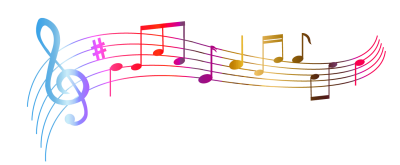News
Musical Symbol – Clef

In this article, let’s tackle briefly about Clef. Understanding what a Clef is, its types, and the type of clef musical instruments used.
What is a Clef?
The term “clef” is derived from the French word “clef,” which means “key.” Clefs are symbols used at the beginning of every piece of a music sheet to indicate the pitch of a written note. There are several types of clefs, each serving a specific purpose in indicating the pitch range of the staff.
Types of Clefs
Based on tessitura, here are the ten clefs placed on lines. In musical notation, Tessitura, or “texture” in English, is the most acceptable range for vocals for a given singer or musical instrument.

In modern music, these are the four clefs that are regularly used, and the Treble and the Bass clefs are the two most common.
Treble clef:
If you are a music student, this is the first clef that you will learn. This clef was used historically to mark a treble, or pre-pubescent, voice part.
Here are the instruments that typically use the treble clef:
- Piano
- Violin
- Flute
- Trumpet
- Clarinet
- Saxophone (soprano, alto, and tenor)
- Oboe
- Guitar (when playing in standard tuning)
- Voice (soprano, mezzo-soprano, alto, tenor)
These instruments generally play in higher registers and are suited to the range covered by the treble clef. However, it’s worth noting that some instruments, like the cello, bassoon, and trombone, can also occasionally use the treble clef for higher passages or transposing instruments.
Bass clef:
Instruments that typically use the bass clef include:
- Double Bass
- Cello
- Bassoon
- Trombone
- Tuba
- Baritone/Euphonium
- Electric Bass Guitar
- Contrabassoon
- Viola (occasionally)
- The left-hand part of the piano (bass clef is used for the left hand, while the right hand typically uses treble clef)
These instruments often play in lower registers and their range is well-suited to the bass clef. However, some instruments, like the piano and some brass instruments, may use both the treble and bass clefs depending on the range of the music being played.
Alto clef:
Instruments that primarily use the alto clef include:
- Viola: The viola is the most common instrument to use the alto clef exclusively.
The alto clef is positioned on the staff such that middle C is in the middle line of the staff, making it well-suited for instruments like the viola that frequently play in a mid-range register. Other instruments that use Alto clef are the Alto trombone and Mandola.
Tenor clef:
Instruments that commonly use the tenor clef include:
- Tenor trombone: In orchestral music, the tenor trombone often uses the tenor clef for its mid-range and higher register passages.
- Cello: While primarily using the bass clef, advanced cello music may employ the tenor clef for passages that extend into higher registers.
- Viola da gamba: This Renaissance and Baroque instrument, similar to the cello, often uses the tenor clef due to its range and characteristics.
The tenor clef is positioned such that the fourth line of the staff represents middle C, making it suitable for instruments with a mid-range register.
Other clefs:
Neutral Clef:

The neutral clef, also known as the percussion clef or indefinite pitch clef, is used for unpitched percussion instruments where specific pitches are not defined. Some instruments that may use the neutral clef include:
- Bass drum
- Snare drum
- Cymbals
- Tambourine
- Triangle
- Gong
- Woodblock
- Temple blocks
- Cowbell
- Bass pedal for a timpani
The neutral clef indicates that the percussionist should focus on rhythm and dynamics rather than specific pitches. It’s often used in percussion music notation to indicate where various percussion instruments should be played in a musical score.
Tablature:

Tablature (often abbreviated as “tab”) is a form of musical notation primarily used for fretted string instruments. Instruments that commonly use tablature include:
- Guitar
- Bass guitar
- Ukulele
- Banjo
- Mandolin
- Lute
- Dulcimer
Tablature provides a visual representation of which strings to play and where to fret them rather than traditional musical notation indicating pitch and rhythm. It’s particularly popular among beginner and amateur musicians for its ease of use in learning and playing songs.
Understanding clefs is fundamental for musicians across various instruments and genres. Whether you’re a violinist navigating the treble clef, a cellist mastering the depths of the bass clef, or a violist exploring the nuances of the alto clef, each clef offers a unique perspective on musical notation and expression. While the clefs may differ, they all serve the same purpose: to guide musicians through the rich tapestry of musical scores, unlocking melodies and harmonies that transcend language and culture. So, whether you’re a seasoned performer or just beginning your musical journey, embrace the clef that resonates with your instrument and dive into the endless possibilities of musical exploration.
Well, this is it for now. Thank you very much for your precious time, I hope to see you again in my next article!


